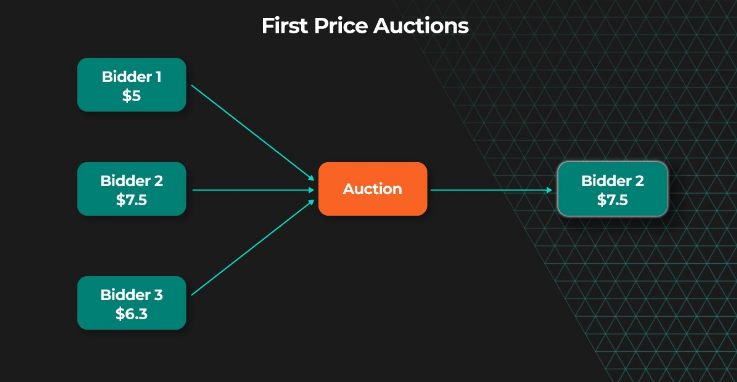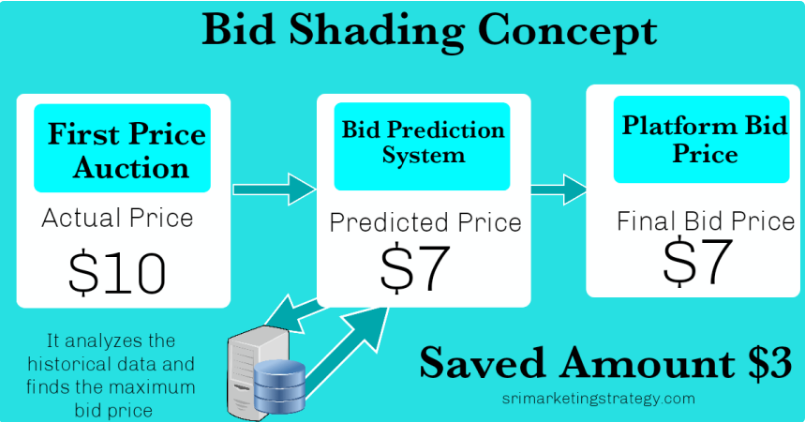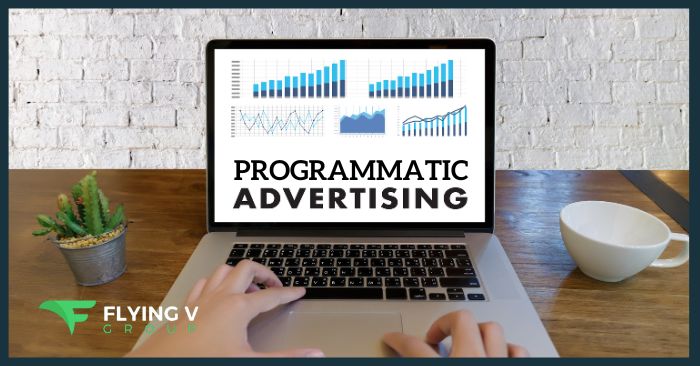Are you struggling to understand first price auctions in digital advertising? These auctions can be intimidating for beginners, but grasping their nuances is crucial for success.
In this guide, we break down the complexity of first price auctions, focusing on their benefits. You’ll learn about the control they provide over ad spending, enabling you to bid in alignment with the value you perceive in ad space, thereby optimizing your budget.
You’ll discover actionable tips to confidently navigate this challenging yet rewarding aspect of digital marketing, setting you up for effective and informed decision-making in your advertising ventures.
- What is a First Price Auction?
- How does the First Price Auction Work?
- Strategies for Succeeding in First Price Auctions: Insights from the Java Jive Billboard Example
- What is Bid Shading?
- First Price Auction Advantages for Beginners in Digital Advertising
- Elevate Your Digital Advertising Journey with Flying V Group
- FAQs
- What is first price auction and second-price auction?
- What are the rules for first price auction?
- What is the best strategy for a first price auction?
- What are the benefits of first-price auction?
- Is there a dominant strategy in first-price auction?
What is a First Price Auction?
A first price auction is a fundamental auction format used in various sectors, including digital advertising.
In this type of auction, multiple bidders compete for a single item or service by placing bids. The bidder offering the highest price wins the auction and pays the exact amount they bid.
This contrasts with a second-price auction, where the winner pays the amount bid by the second-highest bidder.
To illustrate the concept of first price auctions, consider the example of “Java Jive,” a popular coffee shop with a digital billboard. They decide to auction this ad space.
How does the First Price Auction Work?

Understanding the workings of a first price auction is key to mastering bidding strategies in digital advertising. Let’s use the Java Jive billboard auction as a practical example to explain each step and the underlying strategy.
Step 1: Identifying the Auction Item
Java Jive’s Offering: The auction starts with identifying what’s being auctioned — in this case, Java Jive’s digital billboard.
Potential bidders must assess how this specific ad space aligns with their marketing goals and target audience.
Step 2: Calling for Bids
Open for Bidding: Java Jive invites bids for the billboard space.
As a bidder, this is the time to gather information about the ad space, such as viewer demographics and foot traffic, to inform your bidding decision.
Step 3: Placing the Bids
Bid Submission: Here, businesses place their bids based on their valuation of the ad space.
- Brew Bliss bids $100, based on expected return on investment (ROI).
- Bean There bids $120, valuing immediate exposure for their event.
- Cuppa Joe bids $90, balancing risk and potential gain.
The key is to bid an amount that reflects the value the ad space brings to your business without overstretching your budget.
Step 4: Determining the Winner
Highest Bid Wins: In a first price auction, the highest bid secures the item. Strategy Insight: This step highlights the importance of competitive bidding. Bidders must weigh their maximum willingness to pay against the potential benefits of winning.
Step 5: Completing the Transaction
Payment and Ad Placement: The winning bidder, Bean There in this case, pays their bid amount and gains the ad space.
The winner must now capitalize on this investment by creating effective advertising that maximizes the value of their purchase.
Strategies for Succeeding in First Price Auctions: Insights from the Java Jive Billboard Example
1. Value Assessment and the Java Jive Example:
In our Java Jive billboard scenario, Brew Bliss, Bean There, and Cuppa Joe each assessed the billboard’s value based on potential customer reach and ROI. This careful evaluation is key to determining a bid that reflects the true worth of the advertising opportunity.
2. Understanding the Competition:
The participants might have researched each other’s past advertising behaviors. Bean There, understanding the urgency due to their upcoming event, placed a higher bid, while Cuppa Joe stayed conservative, reflecting their limited budget.
3. Setting a Budget Cap:
Each business decided on a maximum bid. Brew Bliss and Cuppa Joe’s strategies were guided by budget constraints, ensuring they did not overextend financially.
4. Psychological Bidding Tactics:
Brew Bliss’s bid of $100 might have been strategically outdone by Bean There’s $120, possibly leveraging the tactic of exceeding common round-number bids.
5. Maintaining Confidentiality:
The businesses kept their strategies and maximum bids confidential, a critical aspect in preventing competitors from gaining an upper hand.
What is Bid Shading?
Bid shading is a strategy used in first price auctions, particularly in programmatic advertising, to counteract the tendency to overpay.
It involves placing a bid that’s lower than what you actually think the item or ad space is worth. This strategy aims to find a balance between winning the auction and not overpaying.

Bid Shading in the Context of the Java Jive Example:
Let’s revisit our Java Jive billboard scenario to understand bid shading:
- The Usual Approach: Normally, Brew Bliss, Bean There, and Cuppa Joe might bid what they believe the billboard space is worth. For instance, if Brew Bliss values the space at $100, that’s what they would bid.
- Applying Bid Shading: However, considering bid shading, Brew Bliss might decide to bid slightly less, say $90, hoping that others are not valuing the space as highly. This approach aims to win the auction at a lower price, saving costs while still achieving their advertising goal.
- Risks and Rewards: While bid shading can lead to cost savings, it also carries the risk of losing the auction if the shaded bid is too low compared to others. For example, if Bean There and Cuppa Joe bid closer to their actual valuations, Brew Bliss’s shaded bid might not be enough to win.
First Price Auction Advantages for Beginners in Digital Advertising
For those new to digital advertising, grasping the benefits of first price auctions is key for successful ad placement and budget control. Here’s how first price auctions can be advantageous:
- Transparency in Bidding: The clear pricing structure of first price auctions means your bid equals your payment, offering straightforward budget planning and reducing the complexity for beginners.
- More Control Over Ad Spending: You have full control over your bid amount, allowing alignment of your spending with the ad space’s value. This control is essential for new advertisers to manage budgets effectively.
- Simplified Bidding Strategy: By focusing solely on the value of the ad space without worrying about second-highest bids, beginners can develop clear, value-based bidding strategies more easily.
- Predictable Competition: First price auctions simplify understanding competitor behavior, as the highest bid wins. This insight aids in learning and strategy formulation.
- Improved Learning Opportunities: These auctions provide immediate market feedback based on winning bids, helping beginners quickly grasp market dynamics and refine their strategies.
Elevate Your Digital Advertising Journey with Flying V Group
Mastering first price auctions is a crucial yet complex aspect of digital advertising. This strategy can be the key to unlocking your ad campaign’s full potential, but navigating it alone can be challenging.
Enter Flying V Group, your solution to the complexities of digital advertising. We specialize not just in winning bids but in crafting campaigns that truly connect with audiences.
By partnering with us, you tackle the problem of navigating first price auctions head-on, transforming potential challenges into triumphant campaigns.
FAQs
What is first price auction and second-price auction?
A first price auction is where the highest bidder wins and pays their bid amount. In a second-price auction, the highest bidder still wins but pays the amount bid by the second-highest bidder plus a small increment.
What are the rules for first price auction?
In a first price auction, each bidder submits a bid without knowing the others’ bids. The highest bid wins, and the winner pays the amount they bid. Bids are typically confidential, and there’s usually only one round of bidding.
What is the best strategy for a first price auction?
The best strategy in a first price auction is to bid slightly higher than what you believe the second-highest bidder will pay. This approach balances the desire to win the auction while not overpaying significantly.
What are the benefits of first-price auction?
First-price auctions offer transparency, as bidders know they will pay exactly what they bid if they win. This simplicity can make bidding strategies more straightforward and reduce the risk of bid shading.
Is there a dominant strategy in first-price auction?
There’s no dominant strategy in first-price auctions due to the uncertainty about other bidders’ valuations. The best approach depends on individual assessment of the item’s value and predictions about competitors’ bids.






0 Comments